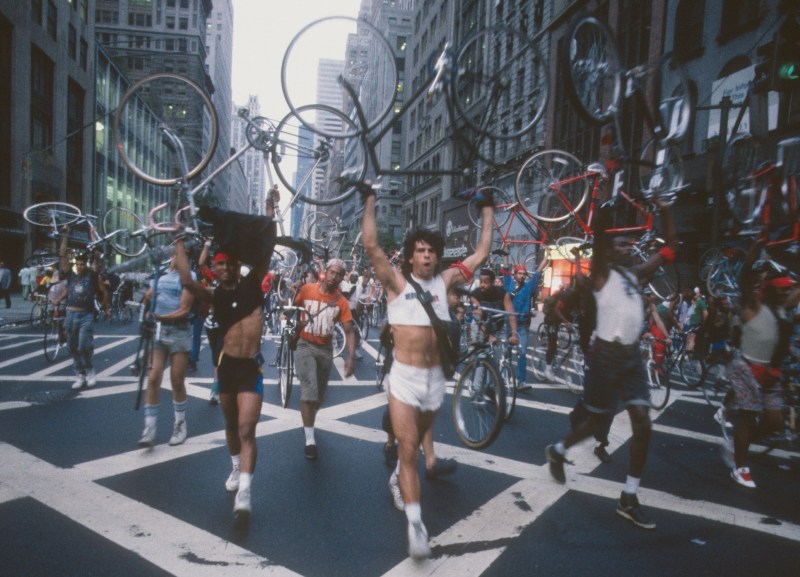New ‘Cycling in the City’ Exhibit Reveals a Long History of Contentiousness

Biking in New York City may seem contentious now, but it’s always been that way. If you think the Skillman Avenue bike lane was controversial, think again: In the late 1800s, cyclists fought back against their ban in Central and Prospect parks and in 1883 were eventually given the right to ride in them, but only with a license issued by the Parks Department.
The tension, fight over public space, and backlash towards bikers is nothing new — cyclists have been at the center of a political battleground in New York City that’s often boiled over onto its streets, causing clashes on the road, for two whole centuries, according to the co-curators of a new exhibit called “Cycling in the City,” on display at the Museum of the City of New York starting on Thursday and running through Oct. 6.
“We wanted to show that the bike has been a contentious issue all along. People know it’s contentious today, people fight back, but actually it’s been contentious since the 19th century,” said Donald Albrecht, the museum’s curator of Architecture and Design. “The streets are a symphony, or a battleground of pedestrians, motor vehicles, and bicycles, and the interplay of the three has always been part of New York.”
The three-part exhibit, which takes a look at the transformation of the physical bicycle and how it has shaped urban transportation and leisure in New York City, also examines the diversity of cycling through the years until the present day. It has old and really old bicycles like penny farthings and velocipedes on display, and even the outfits modest women wore while riding them.


The exhibit also features video clips from cycling advocates, headlines and news articles where bikers were at the center of debate — including most recently Whoopi Goldberg’s comments about how bike lanes ruined New York — and the chance to hop on a stationary Citi Bike for an interactive ride through the park. (Ironically, the Citi Bike coverage area ends about 25 blocks north of the museum.)
The cycling movement has had its ups and downs over the last 150 years, but it’s ultimately made progress: bike lanes are expanding, Prospect Park and Central Park are off-limits to cars, and Citi Bike has become a popular form of transportation for tens of thousands of people every day. And, lest we forget, women are allowed to ride at all, said co-curator Evan Friss, the author of On Bicycling.
“It’s had waves of contentiousness and it changes sometimes the particulars of the debate. In the 19th century there were people saying women shouldn’t even be allowed to ride a bicycle,” he said. “New York is a dense, crowded city. A lot of these debates the stakes were fighting over space in Central Park and Prospect Park.”
But the heart of the debate has always been about the people who ride bikes, not the wheels themselves — then-Mayor Ed Koch banned bike messengers from Midtown Manhattan in 1987, around the same time that messengers, not bikes themselves, were specifically forbidden from entering apartment and building lobbies, said Albrecht.
“Sometimes in the lobby it said ‘No messenger bicycles allowed’ so sometimes it wasn’t against the bicycle, it was against the cyclist, who was wearing a t-shirt and shorts and didn’t look business enough,” he said. “The messengers have been debated from the 19th century to today. It’s still a contentious issue.”
And that same attitude still plays out today as Mayor De Blasio and the NYPD continue their crackdown down on cyclists, particularly on e-bike riders, most of whom are poor, immigrant men of color.
“In the late ’80s in New York, [Koch] saw it kind of as a chaotic city — the messengers were blamed or became some ways the face of some of the problems of New York and the chaos of traffic, what was going on in the streets,” said Friss. “At the same time, there were recreationalists who were seen very differently. They were mostly white, while most of the messengers were not white.”
That demographic remains — but the rise of food apps like Seamless and Grubhub mean that working delivery cyclists are not just racing some documents across town, but speeding dinner to demanding customers. Yet the dynamic remains the same: most people don’t give a second thought to the mayor’s crackdown, even as they take advantage of the work done by these delivery cyclists.
“Because of the food apps, they become more invisible in many ways,” he said. “It’s always been as it is today [with] contentious issues having to do with gender and identity and where people can bike.”

Cycling in the City: A 200-Year History at the Museum of the City of New York (1220 Fifth Ave. between E. 103rd and E. 104th streets in Manhattan), March 14 through Oct. 6. For info, click here.





